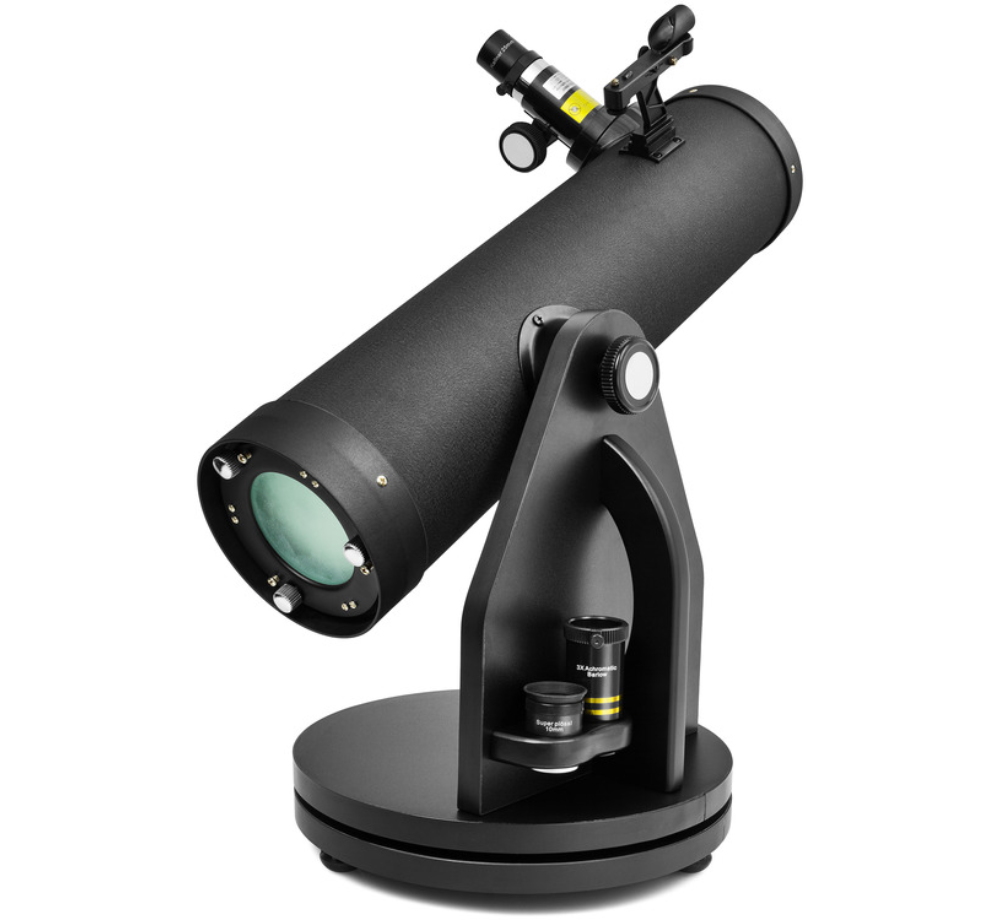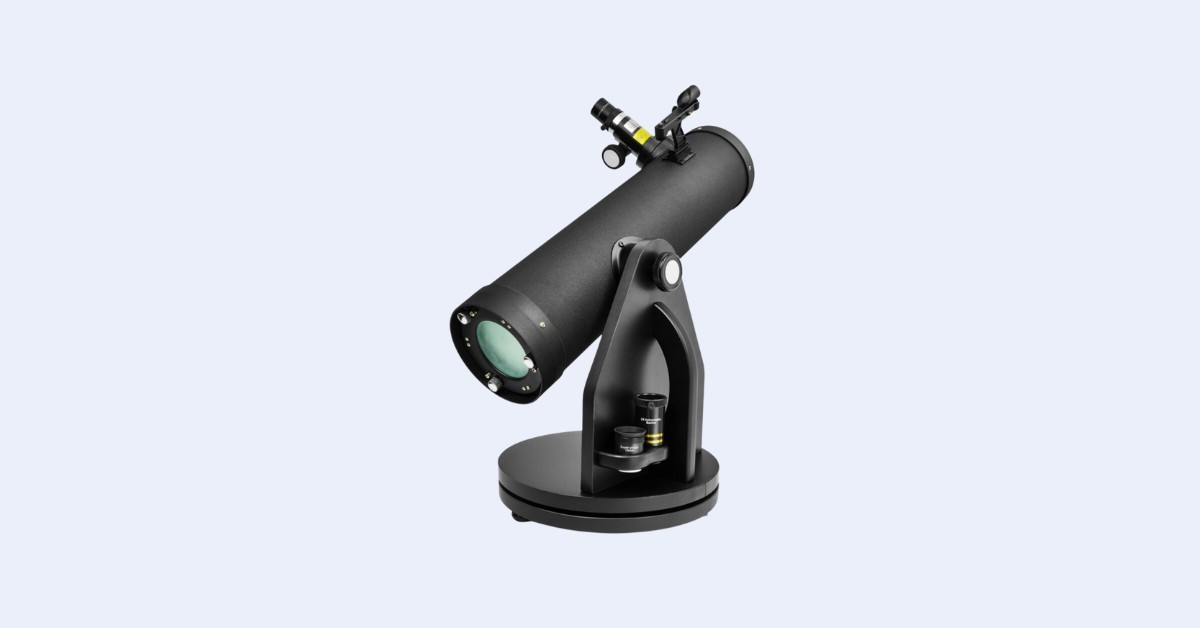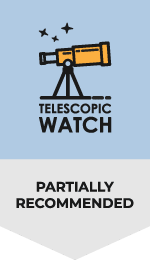The Optical Tube
The Orion SkyScanner BL102 is a 102mm (4”) f/6.3 Newtonian reflector with a resulting focal length of 640mm. The primary mirror in this telescope is spherical in curvature, not parabolic as is the case with most quality Newtonian reflectors. With a long focal ratio, this would not be an issue. A 4.5” f/8 spherical mirror, which is found in many telescopes of acceptable optical quality, deviates from parabolic by less than the minimum criterion (well under ¼ of a wave of spherical aberration) needed for image sharpness due to its weaker curvature. This is not so with the SkyScanner BL102.
The SkyScanner BL102’s mirror has around ¾ of a wave of spherical aberration, which is enough to seriously impact image sharpness at higher magnifications. It’s certainly usable, but put it next to a telescope with good optics of similar aperture and you’ll see a huge difference when viewing high-resolution targets like the Moon, planets, and double stars. A normal 4” telescope can handle up to around 150x–200x magnification; the SkyScanner BL102’s images are noticeably soft and hard to focus above about 100x. The provided focuser doesn’t help. The SkyScanner BL102 uses an extremely cheap focuser from a 60mm “department store” (basically a toy) refracting telescope. This is in contrast to the rather well-designed (though plastic) 1.25″ rack-and-pinion focusers that come with many entry-level telescopes. This focuser is unusually tall and poorly made, suffering from huge amounts of wobble and backlash, making focusing difficult even at lower magnifications. A consequence of the tall focuser I’ve noticed is that the secondary mirror is a bit larger than ideal, at 31% of the primary mirror’s diameter, obstructing more of the primary mirror and somewhat decreasing contrast.

The only upside to the otherwise poorly designed mechanics of the SkyScanner BL102 optical tube is the ease with which it can be collimated. The primary mirror can be adjusted for collimation without tools, and the secondary mirror is adjusted with a Philips head screwdriver. No collimation tools are provided with the SkyScanner BL102, as with most beginner telescopes; consult our collimation guide for more information on collimating and how to make your own collimation cap tool.
The SkyScanner BL102 attaches to its mount directly with a metal adapter that is integrated with the altitude bearing; no rings, clamshells, or dovetail plates are provided, and there is no provision to slide the tube forward or backward for balance. This isn’t a huge inconvenience, but is another corner cut by the manufacturers compared to higher-quality instruments.
Accessories
The SkyScanner BL102 comes with two 1.25” eyepieces: a 25mm Kellner providing 26x magnification and a 10mm Plossl providing 64x. The 25mm Kellner works okay, though the apparent field of view is narrower than it should be (a bit under 50 degrees) and it has lots of glare and ghosting problems, as well as lacking any rubber eye guard. The 10mm “Super Plossl” (KSON apparently does not seem to care for grammar) is extremely uncomfortable to look through. A good 10mm Plossl already has limited eye relief, but this one requires jamming your eye into it so far that your eyelashes obstruct the full field of view. It also has an unusually dim image, a narrow field, glare problems, and generally screams “low quality.”.
The “3x Achromatic Barlow lens” that comes with the telescope is the same horrible, all-plastic junk that comes with Celestron PowerSeeker telescopes and other cheap instruments. It probably costs a few cents to make, and both the body and optics are injection-molded plastic. It also would provide too much magnification in the SkyScanner BL102 (192x) with the 10mm Plossl to be of any use anyway, even if either the eyepiece or Barlow were any good in and of themselves.
For the finder, a red dot sight is provided with the SkyScanner BL102. Normally, we don’t have much to say about red dot finders as they usually work well, but this one is horrid. The viewing window is tinted plastic; the finder is hard to align and struggles to stay that way; it is attached with a non-standard bracket; and the switch is annoying to turn on and off. It detracts even further from using this telescope. Bizarrely, a standard, quality red dot finder will slide onto the upper parts of the provided finder base, so at least it’s easy to fix this problem (albeit at a cost).
Orion also includes a decent moon map by default with the SkyScanner BL102, though you could just download or print one for free anyways.
Mount
The SkyScanner BL102 uses a fairly standard tabletop Dobsonian mount constructed out of particle board. The scope pivots up and down on a ball bearing with a clutch and washers—technically not a true Dobsonian but easy to use nonetheless. The azimuth axis uses the melamine-covered surface of the base gliding against three small plastic pads, and friction can be adjusted by loosening or tightening the lock nut at the middle. The mount works reasonably well, as do most tabletop Dobsonians, and provides smooth motions and rock-steady stability if placed on a stable surface. There’s a built-in carrying handle on the side.
I’ve noticed that the thicker-than-usual particle board used in the SkyScanner BL102’s base, along with the use of cast metal rings on the optical tube ends, make it quite heavy. At 10.5 lbs (4.75 kg), it weighs nearly twice that of the SkyScanner 100 or the Zhumell Z100, which weigh 5.3 lbs (2.4 kg) and 6.2 lbs (2.8 kg), respectively. This is close to the weight of a 114mm reflector like the Zhumell Z114 or Orion StarBlast, which are both 11 lbs (5 kg). Obviously, 10.5 lbs isn’t extremely heavy and is still easy to carry with one hand, but if you’re travelling somewhere with this telescope every extra ounce matters – and if you’re carrying an 11 lb telescope, why not get something with better quality and more performance?
Should I buy a Used Orion SkyScanner BL102?
We wouldn’t recommend a used SkyScanner BL102 unless it was so cheap that buying good accessories for it was much cheaper than buying a new or used high-quality 100mm or 114mm tabletop reflector with parabolic optics. As usual, be sure to check for any obvious mechanical damage or missing parts/accessories, and be sure that the mirrors are not corroded or missing their reflective coatings, though some dust or fingerprints are nothing to be worried about.
Alternative Recommendations
The Orion SkyScanner BL102 is far from our first pick in its price range. Here are some of our alternative recommendations:
Under $200
- The Zhumell Z100 and Orion SkyScanner 100mm are nearly identical to each other, and feature parabolic primary mirrors, unlike the SkyScanner BL102. The shorter 400mm focal length allows for a wider possible field of view, the provided focusers are much less wobbly, the included eyepieces are sharp and less troublesome with glare, and the mounts can even attach to a photo tripod if need be.
- The SarBlue Mak60 with tabletop Dobsonian mount has less aperture than the SkyScanner BL102 but has razor-sharp optics, a fairly decent provided eyepiece, and its diminutive size allows you to bring it with you anywhere.
- The Orion SpaceProbe II 76mm Reflector is a bit smaller than the SkyScanner BL102, but features sharp optics, a pair of quality included eyepieces, a decent red dot finder, and a fairly steady full-sized equatorial mount and tripod, all at a low price tag.
$200-$275
- The Sky-Watcher Heritage 130P has a parabolic primary mirror, a collapsible tube for portability, quality accessories, and significantly more aperture than the SkyScanner BL102 in a similarly convenient tabletop Dobsonian package. A larger version, the Heritage 150P, is also available, as are computerized GoTo versions of both telescopes as the Virtuoso GTi series.
- The Zhumell Z114 and Orion StarBlast 4.5 Astro are similarly identical to each other, as with their 100mm siblings, with slightly larger and thus even better-performing parabolic primary mirror optics, the ability to rotate and slide the tube in its cradle for balance, adjustable collimation, quality included accessories, and a similar total weight to the SkyScanner BL102mm.
- The Orion StarBlast II 4.5 EQ features the same optics and accessories as the StarBlast 4.5 Astro but is mounted atop a full-sized equatorial mount, which is a bit less stable but can be motorized for automatic tracking and even basic astrophotography capabilities.
Aftermarket Accessory Recommendations
If you are, for whatever reason, stuck with the SkyScanner BL102, upgrading from the poor-quality accessories is probably a good idea. A 32mm Plossl eyepiece will provide 20x magnification and a wide 2.6-degree field of view, ideal for viewing deep-sky objects, with a sharper image than the stock 25mm Kellner and much more comfortable viewing.
A 15mm redline eyepiece (43x) will provide a good medium magnification suitable for smaller deep-sky objects and viewing the Moon, while a 6mm “goldline” or “redline” will give you 107x, about the highest magnification usable with the SkyScanner BL102 before its mediocre-quality optics give out.
As previously mentioned, a standard red dot finder of much higher quality than the provided one should slide right onto the existing bracket attached to the SkyScanner BL102, making aiming it a much less frustrating experience.
What can you see with Orion SkyScanner BL102?
The SkyScanner BL102 can show you a lot despite its somewhat-compromised optics. Open star clusters abound in the night sky even when viewed from the city or suburbs, and the brightest stars in them show beautiful colors. Examples include M35, M11, the Double Cluster, and the easily naked-eye visible Pleiades (M45). Even a good 4” telescope doesn’t quite have enough resolving or light-gathering power to show you globular clusters as much more than faint smudges, however, due to their distance and the low brightness of their individual stars. Likewise, planetary nebulae remain similarly out of reach, though you can probably at least detect the huge Dumbbell (M27) and the small but bright Ring (M57).
Under dark skies, you can see quite a few galaxies with the SkyScanner BL102; the Virgo Cluster shows a couple dozen members and you can also look at smaller galaxy groups such as the Leo Triplet. Dark skies will also allow you to see the dust lanes and orbiting companions of M31, the Andromeda Galaxy, and M82, the Cigar Galaxy. Under light-polluted skies, however, only M31 is likely to be visible (albeit as a washed-out smudge) with the SkyScanner BL102 on account of galaxies’ low contrast and brightness. The SkyScanner BL102 does a good job of showing extended wispy gas clouds and their accompanying star clusters in bright nebulae like Orion (M42) and the Lagoon (M8), though the best views are found under dark skies.
The compromised optics of the SkyScanner BL102 put it at a disadvantage for high-resolution viewing of Solar System objects, but it is still sharper than many small, aberration-ridden refractors or far worse telescopes with Bird-Jones or even faster and thus worse spherical optics. It may be a little difficult to see the phases of Mercury with the SkyScanner BL102, though higher magnification should bring out the tiny world, and dazzlingly bright Venus’ phases are easy to see at any magnification. The Moon delights too, with astonishing detail in craters, mountain ranges, and ridges visible even with the so-so optics of the SkyScanner BL102 and regardless of conditions. The polar ice caps and any ongoing dust storms on Mars should be visible too, though spotting any dark markings is likely to require sharper optics and/or a bigger aperture than the SkyScanner BL102 possesses.
The SkyScanner BL102 will have no trouble showing you the moons of Jupiter, and their shadows are visible when they transit across the planet (though their disks may prove hard to spot). Jupiter shows its cloud belts and most broad cloud detail, and the Great Red Spot is just about visible on a good night at high magnification. Saturn’s rings can also be seen, but the Cassini Division within them — normally visible with anything 3” or larger in aperture on a steady night – may prove tough to resolve on account of its razor-thinness, though you should be able to pick out the subtle cloud belts on Saturn and a few of its moons beside it. Uranus and Neptune are mere fuzzy balls, their teal and aquamarine disks vaguely distinguishable from stars at best. As with Pluto, their moons are simply too dim to be viewed with a telescope of this size.



